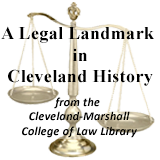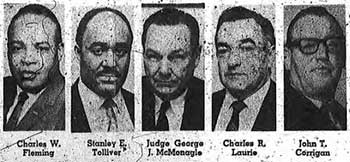The Glenville Shootout and the Trial of Fred Ahmed Evans
Legal Proceedings of Fred Ahmed Evans: Trial
Cuyahoga County Prosecutor John T. Corrigan presented the State's opening statement. He asserted that the State would prove that "Evans and his cohorts purchased rifles, ammunition, first-aid kits and "Murine solution' to wash tear gas out of their eyes," indicating the chaos in Glenville was purposely and deliberately planned in a conspiracy. Defense attorney Charles Fleming painted a different picture of the scenario. He said Evans was not involved in any type of conspiracy and that the violence was "spontaneous," committed by "roving bands of teenagers."1
Part of Evans' defense strategy was to indicate to the jury that some police officers who were killed during the shoot-out would not have died but for the fact that they were intoxicated. The State's first witness, Deputy Coroner William Hoffman testified that Patrolman Louis Golonka, one of the slain officers, was under the influence of alcohol but was not intoxicated when he was slain on July 23rd. According to Hoffman, Golonka's blood alcohol content was .19%, which he estimated as "eight, nine or 10 ounces of whisky or bottles of beer, or of the equivalent." Patrolman Larry Jones had no trace of alcohol in his system. Hoffman's initial autopsy on July 24 found that Lt. Leroy Jones died by a shotgun wound to the neck, but in February the coroner altered the report to state the wound was caused by a high-velocity missile. Hoffman told the court that he made a mistake initially, but that he did not ask police what type of weapons they used the night of the shootout.2
Walter Lee Washington, an eighteen-year-old Black Panther member, was called by the State to testify. Washington testified that Fred Ahmed Evans instructed black nationalists how to use rifles for a "shoot-out with police" just prior to the Glenville incident. Washington testified that there were over forty black nationalists at the meeting. According to Washington the meeting took place at the house of Fred Ahmed Evans. Evans asserted there would be a "revolution" and that Evans demonstrated how to load and unload rifles and shotguns. Washington claimed that in the meeting, Evans said the group needed to buy more rifles and that the group was going to have a shootout with the police. In cross-examination, Attorney Tolliver brought out that Washington was charged with first degree murder, though the Grand Jury returned a "no bill," meaning there was not enough evidence to indict him.3
Thomas Lanier, a Black Panther, also testified that there was in fact a meeting at Evans' home, but the topic was black history, and though there were guns present in the home, there were no demonstrations involving the firearms. Lanier testified that approximately ten individuals were present at the meeting, far fewer than the over forty Washington asserted.4
The State called three employees of nearby stores as witnesses. The clerks testified that they saw Evans buying weapons in the weeks prior to the shootout. One clerk testified that Evans bought guns hours prior to the shootout.5
Walter Beach, Coordinator of the Mayor's Council on Youth Opportunity, testified that the personnel in Cleveland City Hall were aware of unrest in the Glenville neighborhood and knew of possible trouble hours before the gun battle. Beach testified that, in a meeting with City Hall staff on July 23, 1968, news was revealed that an FBI informant reported black nationalists made trips to nearby major cities to obtain weapons and that there was unrest at 12312 Auburndale, which was widely suspected as Evans' residence. Beach testified that he and Councilman George Forbes met with Evans after learning the information provided by the FBI informant. According to Beach, Evans told the two men that he was sick of being harassed by police surveillance. Shortly after the meeting with Evans, the shootout started.6
Dozens of police officers testified in Evans trial, but the testimony of Patrolman Chester Zagore was particularly noteworthy. Zagore testified that he and his partner pulled in front of the tow truck upon arriving at the scene and were met by gunfire. Zagore was hit on the arm and hip. He testified that he heard rapid fire and said that "the ground was blowing up from bullets hitting all around." Zagore observed two or three males firing at him and his partner from the intersection of Beulah and Lakeview. Zagore testified that during the melee he shot two men with a shotgun in the back yard of nearby 1391 Lakeview.7
The defense made a motion to prevent tow-truck operator William McMillan's testimony from being entered into evidence. Judge McMonagle ruled in favor of the prosecution and the testimony was entered into the record. When asked if he was sure Evans was the person who shot him, McMillan stated "Positively…that is the man who shot me."8
The testimonial portion of the trial ended after eighty State witnesses and fifty defense witnesses came to the stand. The jury of seven women and five men, all white, deliberated on the fate of Fred Ahmed Evans and found him guilty for all seven counts of first-degree murder. Evans was sentence to die by electrocution.
1Tony Tucci, "Evans Jury Told Slain Officer Was Drinking," Cleveland Press, Apr. 11, 1969.
2Id.
3Tony Tucci, "Youth Says Evans Trained Rifle Men," Cleveland Press, Apr. 12, 1969.
4Id.
5Edward P. Whalen, "Evans Jury Told of Gun Purchases," Plain Dealer, Apr. 15, 1969.
6Edward P. Whalen, "Riot Hours Told by Mayor's Aide," Plain Dealer, Apr. 16, 1969.
7Tony Tucci, "Patrolman Describes Firing in Glenville," Cleveland Press, Apr. 24, 1969.
8Edward P. Whalen, "Tow Driver Says Evans was Gunman," Plain Dealer, Apr.24, 1969.





